10 Best Live Translation Apps
.webp)
Language barriers are almost done as we approach the end of 2025 and live translation apps are getting better every single day. Whether you want to translate live speech to speech or text, these apps can do it all. With AI technology that is able to understand nuances between different languages depending on context, accuracy has come to a point where errors occur only rarely.
So, let's check out the best live translation apps in the market and see which solution best fits your requirements.
How to Choose the Best Live Translation App for You
Not all real-time translation apps are built the same. Some focus on live subtitling, others on speech-to-speech translation, and some combine everything into one platform. To help you decide, here are the 7 key factors to look for:
- ⚡ Accuracy & Latency – The best live translation apps deliver results in milliseconds, keeping conversations natural without awkward pauses.
- 🌐 Language Support – Some speech translator apps cover 100+ languages, while others focus on fewer but deliver higher accuracy and better context.
- 🎙️ Modes of Live Translation – Look for the specific features you need: live subtitling (speech-to-text), live dubbing (speech-to-speech with voice output), conversational speech-to-speech apps, text-to-text translators, or browser/meeting integrations.
- 🗣️ Voice Naturalness – Some platforms use robotic voices, while advanced tools offer AI voice cloning that preserves your own voice in another language.
- 🔌 Integrations – Seamless compatibility with platforms like Zoom, Microsoft Teams, YouTube, Twitch, and classrooms is essential for professional use.
- ♿ Accessibility – Live captions and subtitles ensure events, meetings, and streams are inclusive for hearing-impaired users.
- 💰 Pricing Models – Free apps are great for travelers, but enterprise-grade live translation solutions usually require subscriptions.
👉 The takeaway: Travelers need portable tools, creators should prioritize dubbing + subtitles, businesses benefit from integrations, and educators thrive with multilingual captions.
Top 10 Live Translation Apps Breakdown
1. Google Translate

When it comes to real-time translation apps, Google Translate is still the world’s most popular choice. Its Conversation Mode allows two people to speak in different languages and see (or hear) live translations instantly. With support for over 100 languages, it’s indispensable for travelers and casual use. While it doesn’t provide dubbing, lip sync, or creator-focused tools, it remains the most accessible free live translator for everyday communication.
Pros
- Supports 100+ languages with wide availability.
- Free and accessible on all devices.
Cons
- Struggles with nuance and longer context.
- No advanced live dubbing or professional integrations.
2. Maestra Live
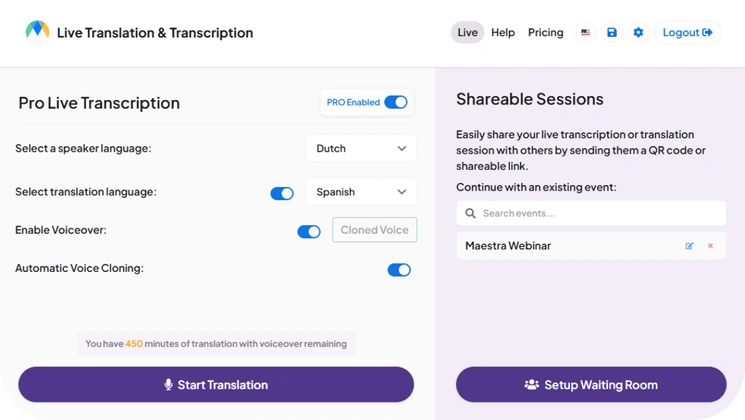
Maestra Live is the ultimate live translation app, providing with a complete platform that offers free live transcription and live captions. And with the pro version, you have live translation, real time dubbing with live voice cloning and multilingual sessions. So, for anyone from businesses to students, Maestra's live translator is an all-around great pick that can solve your issues regarding live translation.
Pros
- All-in-one live translation platform
- Unique features like real time voice cloning and multilingual sessions
Cons
- Requires a subscription for most features
- Needs an internet connection
3. Microsoft Translator

Microsoft Translator is a strong option for real-time classroom translation and multilingual business meetings. It integrates directly into Microsoft Teams, allowing participants to follow meetings in their preferred language with captions. Teachers can create inclusive classrooms where students see live subtitles in real time. While less polished for creators and streaming, it excels for enterprise and education users.
Pros
- Microsoft Teams and Office integration.
- Real-time captions ideal for classrooms.
Cons
- Interface feels enterprise-heavy.
- Not designed for creators or streaming use cases.
4. KUDO
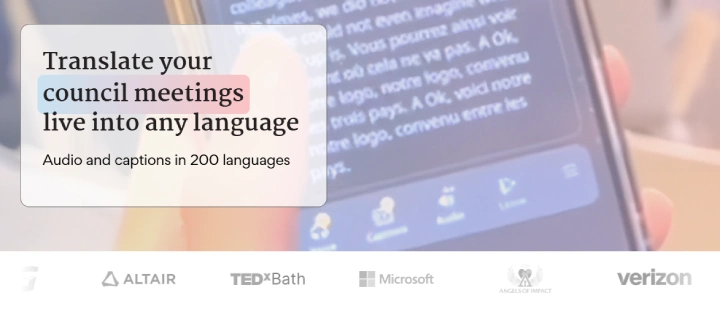
KUDO is designed for enterprise-level simultaneous translation in conferences and professional events. It provides real-time multilingual participation across industries like healthcare, government, and finance. Think of it as the conference-grade AI interpreter. While expensive and complex for casual users, KUDO ensures reliability and accuracy in high-stakes environments.
Pros
- Enterprise-grade live interpretation.
- Trusted in industries requiring precision.
Cons
- Costly compared to consumer apps.
- Overkill for personal or casual needs.
5. DeepL
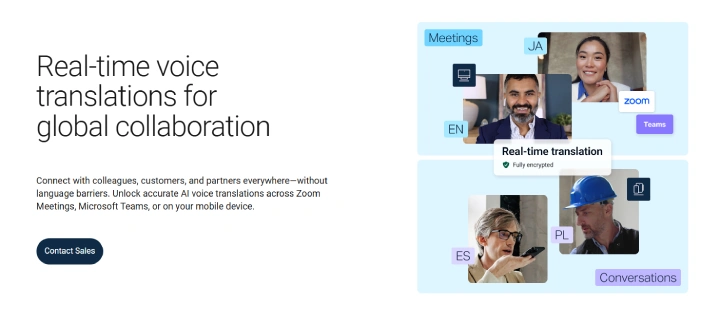
DeepL is best known for text translation accuracy, but it is now expanding into live speech-to-speech translation. Professionals often choose DeepL for its ability to capture nuance and idioms that others miss. Its coverage is narrower than Google Translate, but its accuracy is often superior in supported languages. For businesses and professionals who prioritize correctness over sheer language count, it’s a great option.
Pros
- Highly accurate for professional and nuanced translations.
- Expanding into live voice features.
Cons
- Limited language coverage.
- Not yet strong in real-time dubbing.
6. Pocketalk
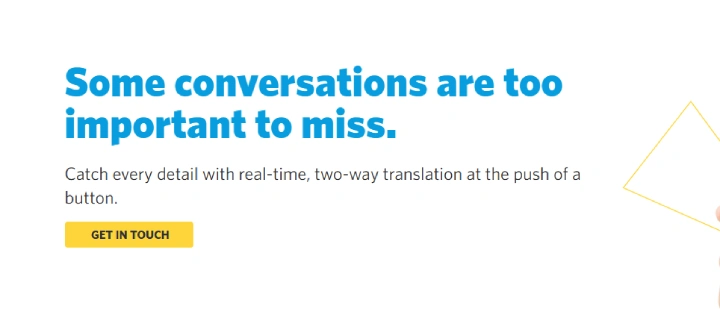
Pocketalk is a dedicated handheld live translator device popular with frequent travelers. It offers two-way speech translation across dozens of languages, with built-in connectivity so you don’t rely on your phone. While it lacks the versatility of app-based solutions, its hardware-first approach makes it reliable abroad. For face-to-face communication, it’s convenient and natural.
Pros
- Dedicated hardware with built-in data.
- Reliable for travel and face-to-face conversations.
Cons
- More expensive than free apps.
- Limited to speech-to-speech translation.
7. Zoom & Teams Live Captions
Both Zoom and Microsoft Teams offer built-in live captions and translations. While not as feature-rich as dedicated tools, they are incredibly convenient for businesses already using these platforms. They allow multilingual participants to follow meetings with automatic captions. Accuracy varies, but for many companies, the convenience outweighs the limitations.
Pros
- Built-in and included in popular conferencing tools.
- No extra cost for existing users.
Cons
- Limited language support.
- Accuracy lags behind dedicated platforms.
8. Veed.io / Streamlabs Plugins
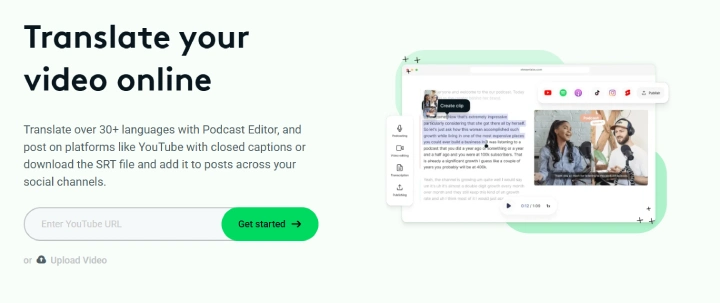
For creators, Veed.io and Streamlabs plugins provide real-time subtitles for live streams. These tools make content accessible to international audiences, especially on Twitch or YouTube. They don’t offer dubbing or voice cloning, but they’re lightweight, affordable, and practical for streamers who want to reach multilingual audiences quickly.
Pros
- Easy setup for streamers.
- Affordable compared to enterprise tools.
Cons
- Subtitles only, no dubbing.
- Accuracy depends on microphone quality.
9. Lingmo Translate
Lingmo is an AI-powered translation solution that combines both mobile apps and dedicated hardware. It’s particularly popular in retail, hospitality, and travel, where businesses need to communicate with customers in real time. The platform supports speech-to-speech translation and also offers enterprise solutions for companies managing multilingual workforces. While not as widely known as Google or Microsoft, Lingmo focuses on business-grade live translation.
Pros
- Strong focus on enterprise and customer service use cases.
- Combines mobile and hardware options for flexibility.
Cons
- Smaller brand, not as globally available as competitors.
- Pricing is higher compared to mainstream apps.
10. SayHi
SayHi is a mobile-friendly live translation app owned by Amazon. It allows users to speak or type and instantly translates into another language with speech or text output. With support for over 90 languages, it’s particularly useful for travelers and casual conversations. Its clean interface and simple design make it approachable for users who don’t want the complexity of enterprise-grade tools.
Pros
- Simple, mobile-focused, and easy to use.
- Free to use with wide language coverage.
Cons
- Limited integrations with professional tools.
- Not designed for creators, educators, or enterprises.
Best Live Translation Apps Comparison Table
| App / Platform | Modes Supported | Languages | Best For | Pricing | Standout Feature |
| Google Translate | Text, Speech-to-Speech | 100+ | Travelers, casual use | Free | Conversation Mode |
| Maestra Live | Live Subtitles, Dubbing, Voice Cloning | 125+ | Creators, businesses, educators | Free/Subscription | All-in-one AI live translation |
| Microsoft Translator | Text, Speech, Captions | 70+ | Education, enterprise | Free / Enterprise | Teams & classroom features |
| KUDO | Speech, Captions, Meetings | 100+ | Conferences, enterprise | Premium | Enterprise-grade live interpreting |
| DeepL | Text, Speech (limited) | 30+ | Professionals, writers | Free / Premium | Superior translation accuracy |
| Pocketalk | Speech-to-Speech Device | 80+ | Travelers | $200+ device | Reliable handheld hardware |
| Zoom / Teams | Captions, Subtitles | Limited | Business meetings | Included | Built into popular platforms |
| Veed.io / Streamlabs | Subtitles for Streams | Limited | Creators, streamers | Subscription | Streaming-focused subtitles |
| Lingmo Translate | Speech-to-Speech, Text | 80+ | Retail, travel, business | Premium | App + hardware flexibility |
| SayHi | Speech-to-Speech, Text | 90+ | Travelers, casual users | Free | Simple, mobile-first experience |
How Live Translation is Evolving
The future of real-time translation apps is driven by AI innovation:
- 🤖 Neural Accuracy: Models are improving at handling idioms, slang, and context.
- 🗣️ AI Voice Cloning: Speak any language in your own voice.
- 👄 Lip Sync Technology: Dubbing that matches mouth movements naturally.
- 🔌 Seamless Integrations: Extensions, conferencing, and streaming apps now include translation by default.
We’re edging closer to the sci-fi dream of a universal translator.
Live Translation Use Cases
- ✈️ Travel: Quick, portable speech-to-speech solutions for tourists.
- 💼 Business: Multilingual meetings with live captions and dubbing.
- 🎬 Content Creation: Subtitles and dubbing for YouTubers, podcasters, and streamers.
- 🎓 Education: Multilingual classrooms powered by live captions.
- ♿ Accessibility: Making events and calls inclusive with AI captions.
- 📡 Streaming & Events: Broadcasting to audiences across multiple languages.
FAQ
What’s the difference between live and traditional translation?
Live translation happens instantly; traditional translation is post-event. Live translation apps use AI technology convert speech ot text or AI-generated speech in real-time.
Which live translation apps are best for travelers?
Google Translate and Pocketalk are best for portability and casual use. Maestra AI is great as long as you have internet connection.
Can live translation work offline?
Google Translate supports offline text; speech-to-speech usually requires internet.
How accurate is live translation apps?
They are extremely accurate, as most of them use the best translation models. And they get more accurate every day as the technology evolves.
Are there free live translation apps?
Yes. Google Translate, Microsoft Translator, and Zoom/Teams captions are free solutions. Maestra AI also has free trials for its premium features.
What’s the best live translation app for international business meetings?
Maestra AI is a great solution for meetings, as you can create multilingual sessions where attendees from different countries can participate in their preferred language. Other than that Google Translate and DeepL are free but clunky solutions for live events.
Do live translation apps protect privacy?
Most use encryption; enterprises should check compliance policies.
What’s the best live translation app for creators?
Maestra AI, with real-time dubbing, subtitles, and integrations with OBS & vMix for live streamers. Veed.io is good as a video translator and Streamlabs is great for content creators producing live or recorded content.
Conclusion
The rise of live translation apps means global communication is faster and easier than ever. Whether you need Google Translate for quick conversations on the go or Maestra for professional-grade subtitling, dubbing, and AI voice cloning, there’s a tool built for your needs. With real-time AI advancing rapidly, we’re closer than ever to a world without language barriers.
